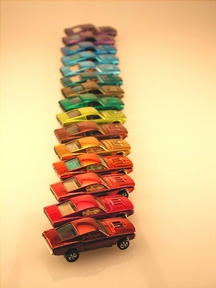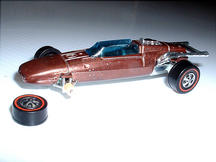The following article was originally published on February 2, 2004 by Tom Barscht and is reprinted with permission.
How 'Hot Wheels' Became Hot Wheels
Curtis Paul
In 1966, Elliott Handler, who was co-running Mattel Toys at that time, wanted to make toy cars. But the task looked daunting.
With Matchbox, Lesney, Corgi, Dinky, Tootsietoy and a host of others making toy cars at the time, why would anyone want to get into the toy car business? In fact, many consultants and Mattel employees said he was crazy to enter such a flooded market. Handler was skeptical, too, but he was also very determined to make a boy's toy counterpart to the successful Barbie line.

Handler came up with the notion of play value. Play value means just what it sounds like a toy that has extended use beyond the way it looks sitting on a shelf.
The cars needed to look great, Handler knew that was a must. But the cars also needed a characteristic that would set them apart from other good-looking cars.
Fast Rides
The idea hit him with such brilliance and simplicity, what if these cars could roll really fast?Matchbox cars looked great, but they didn't roll too well. In fact, good luck getting them to roll more than a few feet. Handler knew that it would be a lot more fun for kids to have a car with wheels that allowed the car to roll with greater ease. With a little push, the new "hot wheel" cars rolled across the floor . . . and kept rolling.
And when thee cars will placed on a ramp, the effect was even better. They really flew!
Believe it or not, there was a lot of engineering that went into these tiny gems. At the time, Mattel had a staff of engineers and designers that had previously worked for some of the larger domestic automakers. Yes, they worked on the real thing.
Mattel had its engineers and attorneys submit patents for the wheel design and the independent suspension system. If one looks closely at the original redline wheels, they appear very wide. However, upon closer inspection, the wheels are somewhat cone-shape and taper slightly from the inside out. When the car rolls on a hard surface, only the very inside edge of the wheel touches the surface, thereby creating less surface resistance and friction.

To achieve this, a very thin axle was attached to the wheel bearing. By chance, Mattel had a ton of Mandolin wire stored in its warehouse that was meant for another toy that was never produced.
The engineers took the very thin wire and created small axles and inserted them into a hard resin plastic called Delrin. The really neat part was that each wheel was able to have some independent spring to it, just like real cars. The combination of the thin axle, unique independent suspension system and the smooth sliding plastic wheels made a very fast car.
Getting the Look
The last key element to the wheels was the look. In Southern California in the mid to late 1960s, a five-spoke chrome "Mag" wheel was very hip. Cragars, as they were called, made an average car look fast and made a fast car look even faster.This was the look that Mattel believed would set their die-cast cars apart from the competition's plain black or gray wheels.
The black plastic wheels were stamped with a five-spoke chrome or silver pattern to re-create the desired look. Another added touch was a redline stripe around the tire, but that is another story (for a future article).
After some time in the design phase, the end product was truly unique and special, having features that no other die-cast car possessed. And, most importantly to Handler, it had play value!
Even though Hot Wheels have changed quite a bit in the last 35 years, they still use the same wheel design principles and they still roll as fast as they did in 1968.
And that's the story of how hot wheels became Hot Wheels.
.
Copyright © 2024
www.HWRedlines.com
All rights reserved.
The pictures and descriptions on this site may not be reused without obtaining prior permission.
Hot Wheels are a registered Trademark of Mattel Inc. This site is
not affiliated with Mattel Inc. in any way.
